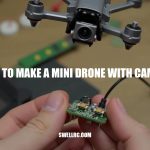How to Start a Nitro RC Car Without Glow Plug Igniter
You set aside an hour to rip around the driveway, fuel bottle ready, pull-start in hand—then realize the glow plug or igniter is missing or dead. I’ve been there. After countless hours of testing in my garage, I turned that frustration into curiosity: could I start a nitro RC car without the usual ignition tools and still do it safely?
This guide distills what actually worked, what didn’t, and how to avoid damaging your engine along the way.
Here’s what you’ll learn: a quick primer on how the ignition system works, safe alternatives to get the coil glowing, warming techniques that make cold starts easier, step-by-step procedures, and pro tips to keep the engine running smoothly once it fires. If you’re just getting into radio control nitro cars and want the confidence to troubleshoot in the field, this is for you. For context on the platform as a whole, see: https://www.swellrc.com/radio-control-nitro-cars/.
Understanding how to start a nitro RC car without glow plug tools is essential for every enthusiast interested in nitro RC car maintenance and rc engine troubleshooting.
Various glow plug alternatives and rc starting methods can help you keep your car running smoothly even when traditional ignition components fail. Exploring these techniques ensures a safer and more reliable operation, allowing you to enjoy your RC car adventures without unnecessary interruptions.
Understanding the role of the glow plug in a nitro RC engine
Understanding the glow plug function is essential for anyone working with an RC ignition system that runs on nitro fuel. A glow plug acts as a tiny, self-heating ignition source; when powered with a typical 1.2V NiMH igniter, its filament glows red-hot, initiating combustion of the nitro fuel mixture—a blend primarily made of methanol, nitromethane, and oil. After starting, the catalytic action between the hot coil and methanol sustains the filament’s heat, enabling the engine to run without external power as long as your tune and compression in nitro engine are adequate.
Fuel quality plays a significant role in engine performance.
The methanol content and nitromethane percentage determine how readily your engine lights and stays lit. For a comprehensive guide on blends and lubricants, resources like this explainer are invaluable.
Identifying signs of a faulty glow plug is straightforward with some basic tests: powering the plug with a known-good 1.2V source should produce an even, bright orange glow across the coil; a multimeter can check for very low resistance indicating good coil continuity; visually, inspect for crushed or broken filaments.
| Component | Function | Failure Sign |
|---|---|---|
| Glow plug | Ignites mixture; maintains hot coil for sustained combustion | No glow under 1.2V, crushed/broken coil, fuel-fouled tip, hard starting |
| Head/heatsink | Retains/controls temperature; affects idle/stability | Runs too cold to self-sustain, frequent flameouts |
| Carburetor/needles | Meter fuel/air for start and run | Over-rich flood, lean stall, erratic idle |
| Fuel (nitro/methanol/oil) | Determines volatility, lubrication, cooling | Wrong blend, stale fuel, poor cold starts |
| Compression (piston/liner) | Seals charge; improves ignition and torque | Weak pinch, needs heavy preheat, won’t hold idle |
Ensuring each component of your RC ignition system is functioning correctly—including assessing compression in nitro engine and maintaining the proper nitro fuel mixture—can dramatically enhance reliability and engine responsiveness. Keeping a close eye out for signs of a faulty glow plug will save you from frustrating no-starts and flameouts, making your RC experience much more enjoyable.
Step-by-step: how to start a nitro RC car without a glow plug (igniter)
Performing nitro starter techniques without a dedicated glow igniter is possible, provided you have a working glow plug installed. Running the engine without a plug isn’t recommended as it risks damage and won’t start. For those lacking an igniter or needing extra heat for sustained running, follow these essential steps:
- Prime and inspect: Fill your fuel tank with fresh fuel, check all fuel lines for cracks or air leaks, and ensure the exhaust pressure line is properly connected.
Prime until fuel reaches the carburetor inlet—avoid over-priming to prevent flooding. If flooded, remove the plug, flip the car over, and use the pull-start procedure several times to clear excess fuel.
- Warm the engine head: Utilize manual heating alternatives like a hair dryer or controlled heat gun to raise the head temperature to around 90–110°C (195–230°F). This promotes better fuel vaporization and eases cranking effort.
Using an IR thermometer can help monitor temperature, but always avoid open flames for safety.
- Power the glow coil without a dedicated igniter: Connect a single 1.2V NiMH or NiCd cell to the glow coil using alligator clips—positive to center post and negative to the body threads—with an expected current draw of 3–5A, holding steady a few seconds. For an 18650 Li-ion battery, regulation is essential; insert a 0.22–0.47Ω, 5W resistor or use a hobby power panel. Avoid direct LiPo connection as it can damage the coil.
If your engine has an onboard glow system, arm it, confirm the status LED is active, and proceed.
- Crank the engine: Use the pull-start procedure involving short, firm pulls with the throttle partially opened to 1/8–1/4. Alternatively, an electric starter box for nitro engine use involves pressing the flywheel down while maintaining a light throttle. Make sure the flywheel rotates in the correct direction to avoid engine damage.
- Establish a stable idle: After the engine fires, maintain a slight throttle to keep it from stalling until the engine head holds heat independently.
If the engine dies after turning off coil power, your fuel mixture might be too rich, or the engine could be too cold. Re-warm and lean the low-speed needle slightly by 1/16 turn increments.
- Perform a quick compression check (pinch test): At idle, pinch the fuel line 2–3 cm from the carburetorto observe RPM changes. A quick rise then stall within 2–4 seconds indicates good tuning.
Immediate stalling points to a lean mixture, while sustained running beyond 5 seconds suggests richness. Lack of RPM change and starting trouble may imply low compression.
Below is a helpful troubleshooting table to resolve common issues encountered during nitro engine startup:
| Problem | Likely Cause | Fix |
|---|---|---|
| Starter spins but no fire | Cold engine head, weak coil heat | Warm the head; verify 1.2V power supply; try a fresh glow plug |
| Fires then stalls on coil removal | Mixture too rich; engine still cold | Lean low-speed needle 1/16 turn; reheat head; raise idle stop 1/4 turn |
| Wet, flooded plug | Over-primed fuel system | Remove plug; clear excess fuel; retry with minimal priming |
| Backfires or kickbacks | Too lean mixture or over-advanced ignition heat | Enrich high-speed needle 1/8 turn; reduce throttle; recheck coil voltage |
| Hard pull or binds near TDC | Thick oil or cold engine pinch | Warm engine head more; apply a drop of after-run oil; turn engine by hand first |
Incorporating these troubleshooting nitro engine tips with the outlined manual and electric starter methods ensures smooth starts and safer operation. For a detailed explanation on working around missing tools, visit the complementary walkthrough on starting a nitro RC car without an igniter at SwellRC.
Advanced tips and tuning after a manual start
Once your nitro RC car engine is running, the goal is to achieve a smooth idle, crisp throttle response, and maintain safe operating temperatures. Here’s a concise guide on how to tune a nitro RC car engine effectively, incorporating key steps like idle screw adjustment, high-speed needle tuning, temperature monitoring nitro engines, and essential post-start optimization tips:
- Set a reliable idle: With the wheels off the ground, adjust the idle stop so the clutch barely doesn’t engage. Aim for a consistent idle without any creeping. This crucial idle screw adjustment ensures your engine runs smoothly at low speeds.
- Dial in the low-speed needle (LSN): Starting from a rich baseline, lean the needle by 1/16 turns incrementally until the launch is clean and free of bogging. Be cautious—if the engine stalls while applying the brake, you’ve leaned it too much.
- High-speed needle (HSN) tuning: Conduct full-throttle runs aiming for a steady thin trail of smoke and a peak speed without power sag. If temperatures climb too rapidly or smoke thins out, enrich the mixture by 1/8 turn to protect your engine.
- Temperature monitoring nitro engines: Typical running temperatures range between 110–135°C (230–275°F), depending on your engine and fuel. Use an infrared thermometer to monitor temps and always tune by combining auditory feedback, smoke quality, and temperature readings—never rely on heat alone.
- Know when to stop improvising: If the engine only runs with external heat or coil power, this indicates a worn-out glow plug or low compression. Replace necessary parts before pushing further to avoid damage.
From personal experience and a full walk-through guide, preheating the engine proved the biggest difference in successful starts, followed by a minor tweak to the LSN. Over-adjusting the throttle or needles often delayed real progress, so patience and subtle refinement are key.
Maintenance and long-term health for nitro engines
Reliability in your nitro RC maintenance routine starts with cultivating solid habits that protect and enhance your engine’s performance. Key practices include:
- Cleanliness: After dusty runs, it’s crucial to perform thorough air filter cleaning to keep grit out of the carburetor and de-gunk the chassis. This prevents contaminants from damaging sensitive components.
For a practical step-by-step guide, visit how to clean nitro RC cars.
- After-run care: Applying a few drops of after-run oil into the carb and glow plug hole and then turning over the engine coats internal parts to protect against rust and corrosion. This simple routine greatly extends engine life.
- Break-in mindset: Respecting the engine break-in period ensures improved compression seal and durability. While this advice centers on ignition systems, the principles are transferable across RC motors.
Check out this engine break-in primer for broader motor care insights.
- Platform perspective: Understanding the differences between gas vs nitro RC cars, especially regarding spark ignition and cold start behavior, informs better maintenance strategies. Explore this comparison at gas-powered RC cars.
- Nitro beyond cars: The ignition principles that apply to nitro RC cars extend to aircraft and race platforms as well. For additional context, see RC plane engines and the RC F1 nitro scene.
- Radio setup sanity: A poorly synced or reversed throttle channel can make starting and tuning your nitro car frustrating.
Ensuring proper radio setup sync is vital. Refresh your skills with this guide: how to sync RC car remote.
By integrating these nitro RC maintenance habits consistently—cleaning the air filter, proper after-run oil application, adhering to engine break-in procedures, understanding gas vs nitro RC differences, considering platform-specific ignition, and maintaining flawless radio setup sync—you’ll prevent most “won’t start” mysteries long before they begin, ensuring smooth and reliable performance every time.
Conclusion: the real lesson behind starting without a glow plug
After hours experimenting with ignition tricks, I finally pieced together how far resourcefulness can take you when starting a nitro car without igniter. Techniques like preheating the head, safely powering the coil without a dedicated igniter, and making micro needle adjustments were the difference between sputtering and success. But the bigger win wasn’t just getting the engine to start—it was gaining mechanical insight that explains exactly why it starts.
Here’s a quick rundown of next steps to maintain performance and reliability:
- Replace a tired glow plug to ensure consistent ignition.
- Confirm compression to verify engine health.
- Retune the LSN (Low-Speed Needle) and HSN (High-Speed Needle) needles for clean launches and safe operating temperatures.
- Stick to a simple cleaning and after-run routine to uphold maintenance discipline.
Connecting the mechanical insight from your tweaks to engine behavior transforms common nitro RC troubleshooting challenges into learning opportunities.
Understanding these core principles fuels not only success but also enjoyment in the hobby. Here’s an engine tuning recap to keep handy:
| Step | Action | Purpose |
|---|---|---|
| 1 | Preheat Head | Facilitates ignition without an igniter |
| 2 | Power Coil Safely | Substitute igniter function |
| 3 | Adjust Needle Valve | Optimize fuel-air mix for smooth running |
| 4 | Check Compression | Ensure engine integrity |
| 5 | Replace Glow Plug | Maintain ignition reliability |
| 6 | Clean & After-Run Care | Prevent buildup and corrosion |
Now that you know how to start a nitro RC car without a glow plug igniter and how to keep it running well afterward, your path becomes clearer. Embrace maintenance discipline and mechanical insight to elevate your nitro RC experience.
Frequently Asked Questions
- What can I use instead of a glow plug igniter?
Use a single 1.2V NiMH/NiCd cell with alligator clips (positive to the center post, negative to the plug body). An onboard glow system, a field power panel, or a regulated 18650 with a 0.22–0.47Ω, 5W series resistor also works. Preheating the head with a hair dryer helps the engine sustain once lit. Avoid unregulated LiPo or 12V sources—these can instantly burn the coil. - How can I tell if my nitro glow plug is actually dead?
Bench-test with a known-good 1.2V source: a healthy plug glows evenly orange across the coil in 2–3 seconds. If only the tip glows, it’s weak; if there’s no glow, it’s dead. Check continuity with a multimeter (very low resistance). Inspect the filament for cracks or a crushed coil. In use, signs include hard starting, flooding, or stalling as soon as you remove coil power. - Can a nitro RC car start with low compression?
It’s difficult and often unreliable. You can warm the head to improve seal, use a drop of after-run oil to help the pinch, and richen slightly for lubrication, but these are temporary. Do a pinch test: at idle, pinch the fuel line; a stall in 2–4 seconds is normal. Immediate stall can be lean; 5+ seconds suggests rich; little change with stubborn starts points to low compression. Ultimately, replace the piston/liner if compression is weak. - Is it safe to heat the glow plug manually?
Yes—if you use the correct low-voltage method. A 1.2V NiMH with good clips is safest. Regulated Li-ion with a small series resistor also works. Do not use open flames or unregulated high voltage. Limit coil heating to a few seconds before cranking, and avoid prolonged glowing without airflow to prevent coil damage. - How do you tune a nitro engine after starting it without a glow plug igniter?
Stabilize idle first, then adjust the low-speed needle in 1/16-turn steps for clean launches and no bog. Set the high-speed needle using full-throttle passes—look for steady power with a thin smoke trail and safe temps. Recheck idle stop so the clutch doesn’t drag. A full guide is here: https://www.swellrc.com/how-to-tune-a-nitro-rc-car-engine/



